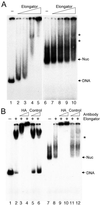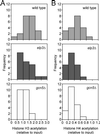Elongator is a histone H3 and H4 acetyltransferase important for normal histone acetylation levels in vivo
- PMID: 11904415
- PMCID: PMC122555
- DOI: 10.1073/pnas.022042899
Elongator is a histone H3 and H4 acetyltransferase important for normal histone acetylation levels in vivo
Abstract
The elongating, hyperphosphorylated form of RNA polymerase II is associated with the Elongator complex, which has the histone acetyltransferase (HAT) Elp3 as a subunit. Here we show that, in contrast to the isolated Elp3 subunit, the activity of intact Elongator complex is directed specifically toward the amino-terminal tails of histone H3 and H4, and that Elongator can acetylate both core histones and nucleosomal substrates. The predominant acetylation sites are lysine-14 of histone H3 and lysine-8 of histone H4. The three smallest Elongator subunits--Elp4, Elp5, and Elp6--are required for HAT activity, and Elongator binds to both naked and nucleosomal DNA. By using chromatin immunoprecipitation, we show that the levels of multiply acetylated histone H3 and H4 in chromatin are decreased in vivo in yeast cells lacking ELP3.
Figures





Similar articles
-
The silencing complex SAS-I links histone acetylation to the assembly of repressed chromatin by CAF-I and Asf1 in Saccharomyces cerevisiae.Genes Dev. 2001 Dec 1;15(23):3169-82. doi: 10.1101/gad.929001. Genes Dev. 2001. PMID: 11731480 Free PMC article.
-
Identification and analysis of yeast nucleosomal histone acetyltransferase complexes.Methods. 1998 Aug;15(4):315-21. doi: 10.1006/meth.1998.0635. Methods. 1998. PMID: 9740719
-
Histone H3 specific acetyltransferases are essential for cell cycle progression.Genes Dev. 2001 Dec 1;15(23):3144-54. doi: 10.1101/gad.931401. Genes Dev. 2001. PMID: 11731478 Free PMC article.
-
Histone acetylation: facts and questions.Chromosoma. 1994 Dec;103(7):441-9. doi: 10.1007/BF00337382. Chromosoma. 1994. PMID: 7720410 Review.
-
Acetylation of histones in nucleosomes.Mol Cell Biochem. 1982 Apr 30;44(2):113-28. doi: 10.1007/BF00226895. Mol Cell Biochem. 1982. PMID: 6808351 Review. No abstract available.
Cited by
-
Elongator controls cortical interneuron migration by regulating actomyosin dynamics.Cell Res. 2016 Oct;26(10):1131-1148. doi: 10.1038/cr.2016.112. Epub 2016 Sep 27. Cell Res. 2016. PMID: 27670698 Free PMC article.
-
SSD1 modifies phenotypes of Elongator mutants.Curr Genet. 2020 Jun;66(3):481-485. doi: 10.1007/s00294-019-01048-9. Epub 2019 Nov 27. Curr Genet. 2020. PMID: 31776648 Free PMC article. Review.
-
The Arabidopsis Elongator Subunit ELP3 and ELP4 Confer Resistance to Bacterial Speck in Tomato.Front Plant Sci. 2018 Jul 24;9:1066. doi: 10.3389/fpls.2018.01066. eCollection 2018. Front Plant Sci. 2018. PMID: 30087688 Free PMC article.
-
IKAP/hELP1 down-regulation in neuroblastoma cells causes enhanced cell adhesion mediated by contactin overexpression.Cell Adh Migr. 2010 Oct-Dec;4(4):541-50. doi: 10.4161/cam.4.4.12923. Cell Adh Migr. 2010. PMID: 20671422 Free PMC article.
-
Mutant casein kinase I (Hrr25p/Kti14p) abrogates the G1 cell cycle arrest induced by Kluyveromyces lactiszymocin in budding yeast.Mol Genet Genomics. 2003 May;269(2):188-96. doi: 10.1007/s00438-003-0807-5. Epub 2003 Feb 13. Mol Genet Genomics. 2003. PMID: 12756531
References
-
- Kornberg R D, Lorch Y. Cell. 1999;98:285–294. - PubMed
-
- Kornberg R D, Lorch Y. Curr Opin Genet Dev. 1999;9:148–151. - PubMed
-
- Workman J L, Kingston R E. Annu Rev Biochem. 1998;67:545–579. - PubMed
-
- Stallcup M R. Oncogene. 2001;20:3014–3020. - PubMed
-
- Brownell J E, Zhou J, Ranalli T, Kobayashi R, Edmondson D G, Roth S Y, Allis C D. Cell. 1996;84:843–851. - PubMed
Publication types
MeSH terms
Substances
Grants and funding
LinkOut - more resources
Full Text Sources
Other Literature Sources
Molecular Biology Databases

